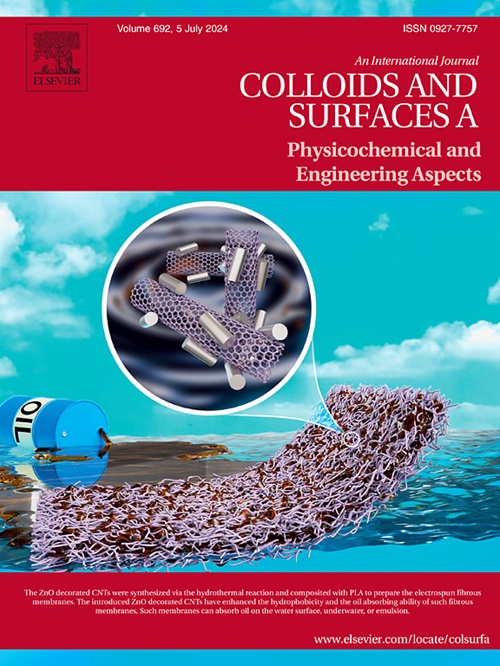Insight into the enhanced electrocatalytic performance of double-layer Ti/Fe2O3/Ce-PbO2 anode for levofloxacin degradation
IF 4.9
2区 化学
Q2 CHEMISTRY, PHYSICAL
Colloids and Surfaces A: Physicochemical and Engineering Aspects
Pub Date : 2025-04-29
DOI:10.1016/j.colsurfa.2025.137078
引用次数: 0
Abstract
In this work, a novel double-layer Ti/Fe2O3/Ce-PbO2 (TFCP) electrocatalyst anode was developed on Ti substrate through the consecutive electrodeposition process with Fe2O3 and Ce-PbO2 as the inter-layer and external layer materials, respectively. Compared with Ti/Fe2O3 (TF) and Ti/Ce-PbO2 (TCP), the TFCP endows superior degradation efficiency toward levofloxacin (LFX) up to 92 % within 120 min, while TF and TCP only achieve 68.6 % and 59.7 %, respectively. The improved electrocatalytic performance can be primarily attributed to the introduction of an Fe2O3 interlayer beneath of the Ce-PbO2, which results in lower charge transfer resistance, larger electroactive area, and higher oxygen evolution potential of the TFCP electrode in comparison to TF and TCP electrodes. Radical capture assays demonstrates that ·OH and ·O2- are responsible for the degradation of LFX, with ·OH being the primary reactive oxygen species (ROS). Moreover, the possible degradation routes of LFX were plausibly inferred based on the identification of degraded intermediates via liquid chromatography-mass spectrometry (LC-MS) technique together with theoretical calculation with density functional theory (DFT). In conclusion, this work provides a novel guideline for designing novel double layer anode for efficient degradation of refractory organic contaminants.
双层Ti/Fe2O3/Ce-PbO2阳极对左氧氟沙星降解电催化性能的增强研究
本文以Fe2O3和Ce-PbO2分别作为中间层和外层材料,通过连续电沉积工艺,在Ti衬底上制备了一种新型的双层Ti/Fe2O3/Ce-PbO2 (TFCP)电催化剂阳极。与Ti/Fe2O3 (TF)和Ti/Ce-PbO2 (TCP)相比,TFCP在120 min内对左氧氟沙星(LFX)的降解效率高达92 %,而TF和TCP分别仅为68.6% %和59.7 %。电催化性能的提高主要是由于在Ce-PbO2下面引入了Fe2O3中间层,与TF和TCP电极相比,TFCP电极的电荷转移电阻更小,电活性面积更大,析氧电位更高。自由基捕获试验表明,·OH和·O2-负责LFX的降解,其中·OH是主要的活性氧(ROS)。此外,通过液相色谱-质谱(LC-MS)技术对降解中间体进行鉴定,并结合密度泛函理论(DFT)进行理论计算,合理地推断了LFX可能的降解途径。总之,本研究为设计高效降解难降解有机污染物的新型双层阳极提供了新的指导。
本文章由计算机程序翻译,如有差异,请以英文原文为准。
求助全文
约1分钟内获得全文
求助全文
来源期刊
CiteScore
8.70
自引率
9.60%
发文量
2421
审稿时长
56 days
期刊介绍:
Colloids and Surfaces A: Physicochemical and Engineering Aspects is an international journal devoted to the science underlying applications of colloids and interfacial phenomena.
The journal aims at publishing high quality research papers featuring new materials or new insights into the role of colloid and interface science in (for example) food, energy, minerals processing, pharmaceuticals or the environment.

 求助内容:
求助内容: 应助结果提醒方式:
应助结果提醒方式:


